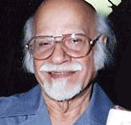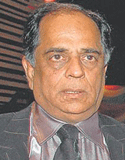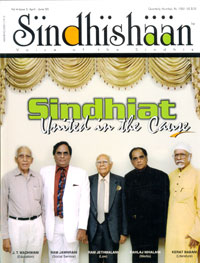SINDHIAT – A POINT OF VIEW
By Ranjit Butani

The signs are favourable. With the release of every issue ‘Sindhishaan’ receives a spate of letters, and e-mails on its website from the Sindhi youth, asking questions about Sindhiat. This desire to know more, amongst the youth of to-day, is truly a welcome and heartening sign.
In this feature ‘Sindhishaan’ has put forth some of the most frequently asked questions to a panel comprising of eminent personalities – Shri Ram Jethmalani, Shri Jhamatmal T. Wadhwani, Shri Kerat Babani and Shri Pahlaj Nihalani – none of whom need any introduction within the Sindhi community; or for that matter even outside the community.
Shri Ram Jawhrani (RJA),  who also needs no introduction tossed the issue across the panel and received a very interesting and thought provoking response – recorded here for the benefit of the readers of Sindhishaan.
who also needs no introduction tossed the issue across the panel and received a very interesting and thought provoking response – recorded here for the benefit of the readers of Sindhishaan.
RJA : Whether the community’s belief in Uderolal or Jhulelal, as its deity, has its origins from the times of pre-partition Sindh or is it something propagated post partition by Prof. Ram Panjwani to unite the community – by encouraging the Sindhis to come on a common platform to celebrate ‘Chetichand’ and thereby interact amongst each other during the festivals inculcating a common and uniform identity?
Ram Jethmalani (RJE) :  There is no doubt that Prof. Ram Punjwani did a wonderful job of reviving the tradition of celebrations on Chetichand and his tremendous efforts were a shot in the arm of the Sindhi unification movement after partition in India – the belief in Jhulelal as being the community’s ‘Ishtdev’ was definitely prevalent in Sindh during the pre-partition days because I distinctly recollect having heard & being aware about ‘Jhulelal’ since the time I was a 3 year old kid. It is certainly not a post partition phenomenon but a very old tradition; perhaps as old as our culture which is derived from the Indus valley civilization which developed on the banks of the Indus. It is pertinent to note that ‘Jhulelal’s’ transport as depicted since time immemorial is the “pallo” fish which remains stable inspite of any turbulence in the water, and was found in abundance in the Indus.
There is no doubt that Prof. Ram Punjwani did a wonderful job of reviving the tradition of celebrations on Chetichand and his tremendous efforts were a shot in the arm of the Sindhi unification movement after partition in India – the belief in Jhulelal as being the community’s ‘Ishtdev’ was definitely prevalent in Sindh during the pre-partition days because I distinctly recollect having heard & being aware about ‘Jhulelal’ since the time I was a 3 year old kid. It is certainly not a post partition phenomenon but a very old tradition; perhaps as old as our culture which is derived from the Indus valley civilization which developed on the banks of the Indus. It is pertinent to note that ‘Jhulelal’s’ transport as depicted since time immemorial is the “pallo” fish which remains stable inspite of any turbulence in the water, and was found in abundance in the Indus.
Jhamatmal Wadhwani (JTW) : The practise of worship of Darya Shah goes back almost 1000 years. Amarlal’s birth was the coming into being of the Messiah of the Sindhi community as is widely known; to protect the Sindhis from persecution and conversion of faith as was attempted during those times. To Prof. Ram Panjwani goes the credit of reminding us of our traditions and bringing us back on the track of “dharm”; as after partition the community got totally engrossed in sustainance and survival; and immersed themselves in the pursuit of material resources.
The practise of worship of Darya Shah goes back almost 1000 years. Amarlal’s birth was the coming into being of the Messiah of the Sindhi community as is widely known; to protect the Sindhis from persecution and conversion of faith as was attempted during those times. To Prof. Ram Panjwani goes the credit of reminding us of our traditions and bringing us back on the track of “dharm”; as after partition the community got totally engrossed in sustainance and survival; and immersed themselves in the pursuit of material resources.
RJA : Have we succeeded or rather the pre-partition generation succeeded in ensuring that our identity – traditions, culture is passed on to the next generation?
RJE : The identity of any community is recognised by its language and script. These are the basic foundations which cannot be compromised, and need to be preserved at all costs. It is difficult to answer in simple terms whether our generation has performed its duty towards this end. We are all aware of the depressing fact that Sindhi is no longer spoken in all Sindhi homes and there were apprehensions that in another 15-20 years the language will disappear from the face of the earth altogether. However it must now be recognised that during the last couple of years a very strong movement has begun; to keep the language alive and I am sure this will succeed.
JTW : You hear about “Sindhiat bachao” at almost all community gatherings and fora. What is Sindhiat? Sindhiat is our language, Sindhiat is our festivals, our folklore, our music, our dress, our traditions. Classes to teach Sindhi have sprung up all over the country and there has been a “hulchul” during the last 3 years. Unfortunately there has been a slight slackening of the efforts off late due to financial constraints – teachers have not been paid their dues. But I am certain this will soon be resolved.
Kerat Babani (KBA) :  The centres of Akhil Bharat Sindhi Boli ain Sahit Sabha throughout India have succeeded in keeping the language and culture very much alive. Through literary gatherings, seminars, workshops and drama we have been able to spread the message of revival and there has been tremendous participation and devotion towards this cause. I strongly believe that vocal culture is a powerful medium through which the younger generation can be reached and I wish mobile troups could be formed who can spread the message of ‘Sindhiat’ – via dance, drama, music, folklore to all corners of the globe.
The centres of Akhil Bharat Sindhi Boli ain Sahit Sabha throughout India have succeeded in keeping the language and culture very much alive. Through literary gatherings, seminars, workshops and drama we have been able to spread the message of revival and there has been tremendous participation and devotion towards this cause. I strongly believe that vocal culture is a powerful medium through which the younger generation can be reached and I wish mobile troups could be formed who can spread the message of ‘Sindhiat’ – via dance, drama, music, folklore to all corners of the globe.
Pahlaj Nihalani (PNI) :  Parents should realize that it is their responsibility to ensure that their children speak Sindhi at home. Off course they may speak English or Hindi or another language with friends or at their workplace but Sindhi must be mandatory at home. Belonging to the film fraternity I strongly believe that ‘Sindhiat’ can be successfully propagated through the audio visual medium. We’re all aware of the telecast of Sindhi programmes from Pakistan Television. We too must start a dedicated Sindhi channel or to begin with take time slots on existing channels and telecast Sindhi programmes produced to generate interest in our youth which could simultaneously be educative and provide knowledge and understanding of our heritage, customs, culture – through dance, drame, quiz shows etc.
Parents should realize that it is their responsibility to ensure that their children speak Sindhi at home. Off course they may speak English or Hindi or another language with friends or at their workplace but Sindhi must be mandatory at home. Belonging to the film fraternity I strongly believe that ‘Sindhiat’ can be successfully propagated through the audio visual medium. We’re all aware of the telecast of Sindhi programmes from Pakistan Television. We too must start a dedicated Sindhi channel or to begin with take time slots on existing channels and telecast Sindhi programmes produced to generate interest in our youth which could simultaneously be educative and provide knowledge and understanding of our heritage, customs, culture – through dance, drame, quiz shows etc.
RJA : We’re aware that Sindhis have made great contribution to the Hindi film Industry – right from financing, production, distribution, exhibition etc. Why is it that no Sindhi films are produced whereas earlier a few films were produced?
PNI : As a matter of fact I’m already working on such a project. I fully realize that the youth of to-day is enormously inspired and impressed by the visual media. I am going to present Sindhi culture in the modern format. My team is already in the process of carrying out relevant research and the concept I will present will be not only for the Sindhi populace in India – but the world over. It will project ‘Sindhiat’ on a macro level, inclusive of art, music, paintings, folklore, literature etc. And I’m pleased to state that a number of like minded members of the community are working together with me on this project.
RJA : Hardly has the dust settled on the National Anthem controversy that we are confronted with yet another affront in the form of renaming “SINDHU DARSHAN” as “SINH DARSHAN” by the Hon’ble Minister of Tourism – Renuka Choudhry. What steps should the community take to ensure that it does not become the butt of ridicule every now and then?
RJE : As in the case of the National Anthem – this issue too will be resolved favourably. Publicity seeking individuals like Bhatnagar take up such issues and we help them by giving them the publicity they seek – Appreciate the fact that although a negligible %age of the country’s population we have persons from our community having occupied and occupying the highest posts – public, private and government with the office of even Dy PM – being held by a Sindhi. So what is there to be apprehensive! I know Renuka Chaudhry personally and I am sure she has been misinformed.
JTW : Besides the Bharat Sindhu Sabha several organisations have been regularly going on ‘Sindhu Darshan’ since ’99. During the first year there were hardly 75 visitors but the last year had visitors numbering over 1000. and the visitors were not restricted to the Sindhi community only but came from all parts of India. It must be borne in mind that Indus does not belong to Sindhis only but to all Hindus. They are part and parcel of the great ancient civilisation that developed on its banks. Even the official government document mentions the event as ‘SINDHU DARSHAN’. So where is the question of renaming it? As a matter of fact work has already commenced on the construction of a Jhulelal mandir as a pilgrimage site and a cultural centre is also in the pipeline.
KBA : Throw a stone to cause ripples. It is a standard practice of the politicians to stir a controversy and gain importance. There is no substances in this renaming concept and it will die its natural death.
RJA : What is the message to the youth of the community on this auspicious occasion of Chetichand?
RJE : I can enunciate 2 qualities that the youth must strive to acquire
(1) Purity of character : In times when we are witness to wanton corruption in our daily life the youth must adhere to high principles and morals to maintain a clean & pure character.
(2) Sound education : To survive and become a success in the current competitive world it is imperative that the youth educate themselves adequately to enhance their knowledge and intelligence.
JTW : I will only exhort the youth to continue with their efforts. It may not be obvious in big cities but in the interiors and metros the youth is very active. They speak Sindhi and believe in Sindhiat. In cities too, things are improving greatly. There is a movement to unite all panchayats and bring them on a common platform to lend strength to their voice and bring about unity amongst Sindhis. If the momentum is maintained there will be no looking back.
KBA : There is no need to give any advise to our youth. They are bold, courageous and intelligent enough to take the right decisions. Isn’t this apparent from the heights they have scaled. My only advise is to unite and keep the language alive.
And on that note the discussions were concluded, with a surge of optimism that NOTHING IS LOST. THE SINDHI COMMUNITY IS ON THE SPRINGBOARD AND READY TO SOAR HIGHER TO GREATER GLORIES IN BOTH THE MATERIAL AND SPIRITUAL WORLDS. THE EFFORTS OF OUR COMMUNITY STALWARTS WILL NOT HAVE BEEN IN VAIN.


